Caponata
A classic Sicilian sweet and sour eggplant stew with capers, olives, and celery in agrodolce sauce.
👉 View Authentic Recipe 👈
About This Dish
Caponata is a quintessential Sicilian dish that showcases the island’s rich culinary heritage and Arab influences. Dating back to the 18th century, this eggplant-based antipasto perfectly embodies Sicily’s approach to cooking: transforming humble ingredients into complex, flavorful preparations. The dish exemplifies the agrodolce (sweet and sour) flavor profile that distinguishes much of Sicilian cuisine from mainland Italian food.
Traditional caponata combines fried eggplant with celery, onions, tomatoes, olives, and capers, all seasoned with vinegar and sugar to create its characteristic sweet-sour taste. Regional variations exist throughout Sicily, with Palermo versions often including octopus, while those from Catania might incorporate peppers or potatoes. The vegetables are typically cut into uniform cubes and cooked separately before being combined, allowing each ingredient to maintain its distinct texture.
Historically served as a side dish or antipasto at room temperature, caponata was originally a practical way to preserve vegetables in Sicily’s hot climate. Today, it remains a staple of Sicilian tables, particularly during summer months when eggplants are at their peak. The dish is typically prepared in large batches, as its flavors improve over 1-2 days of resting, making it an ideal make-ahead offering for family gatherings and celebrations.
🧑🍳 Analyzed by CucinaBot
Why This Dish Works
Caponata’s culinary magic lies in its perfect balance of five fundamental tastes. The acidic vinegar and sweet sugar create the signature agrodolce base, while capers and olives provide salty, briny notes with natural glutamates (umami). The separate frying of eggplant creates caramelization through the Maillard reaction, adding depth, while the celery’s high water content provides textural contrast to the soft, oil-rich eggplant.
Key Success Factors
- Proper Eggplant Preparation: Salt and drain eggplant for at least 30 minutes to remove bitterness and prevent excess oil absorption
- Sequential Cooking: Fry ingredients separately before combining to maintain textural integrity and distinct flavors
- Balanced Agrodolce: The sweet-sour ratio should be harmonious, with neither sugar nor vinegar dominating
- Resting Period: Allow caponata to sit at least 12-24 hours before serving for flavors to fully develop and meld
Common Pitfalls
Many non-authentic recipes rush the process by cooking all vegetables together, resulting in a mushy texture with muddled flavors. Another common mistake is using too little oil when frying the eggplant, causing it to become dry and chewy rather than silky and tender. Some recipes also incorrectly omit the crucial resting period, serving caponata immediately when its flavors haven’t properly developed.
How to Judge Authenticity
When reviewing recipes, look for these markers of authenticity:
- Includes a proper agrodolce preparation with both vinegar and sugar in balance
- Specifies salting and draining the eggplant before cooking
- Calls for frying ingredients separately before combining
- Contains celery (a non-negotiable ingredient often omitted in inauthentic versions)
- Recommends serving at room temperature, not hot, after a significant resting period